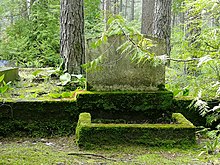Marie Reisik
Marie Reisik (born February 6, 1887 as Marie Tamman in Kilingi-Nõmme, Pärnumaa ; † August 3, 1941 in Tallinn , Harjumaa ) was an Estonian feminist , teacher and politician . At the beginning of the 20th century she was the face of the Estonian women's movement .
Life

childhood and education
Reisik was the fourth child of flax traders Tõnis Tamman and Liisa Tamman . Her father owned three houses in Kilingi-Nõmme. Personalities from the art and cultural scene such as Mina Härma , Anna Haava and Aino Tamm came to visit regularly . The encounters encouraged Reisik to pursue her political and feminist endeavors in her later career.
Reisik attended the Russian-speaking girls' high school in Pärnu . During her school days she read modern European literature and was interested in philosophy and world affairs. In addition to Estonian , she spoke fluent English , German , Russian and French and was aiming to train as a teacher. In April 1908 she went to Paris for a few months to improve her French language skills and to obtain a diploma as a French teacher. Upon her return in early August that year, she taught at a community school in Torma . In 1910 she moved to Tartu and took a job at a primary school .
Married life with Peeter Reisik
In 1911 Marie married the lawyer Peeter Reisik and took his family name . Between 1906 and 1922 they had a lively correspondence whenever they were apart for some time. They wrote about 800 letters about their love for one another and their current life situation. During her studies in Paris Reisik reported on her studies, her travel experiences and the cultural life in France .
Feminist and political engagement
In 1907 Reisik was co-founder of the first women's organization Eesti Naesterahvaste Selts in Tartu. In the context of events, women's rights were promoted, but household and handicraft courses were also offered for women and the magazine Käsitööleht was published on craft topics.
In 1911 Reisik founded the first Estonian women's magazine under the title Naisterahva Töö ja Elu as an appendix to the Käsitööleht , which was designed for a female audience and dealt with women's rights and household issues. She was editor-in-chief until 1918 . Among the authors of the articles were some cultural personalities of this time such as Lilli Suburg , Alma Ostra-Oinas , Marta Lepp , Johanna Sild-Rebane , Marta Sillaots and Salme Pruuden .
In May 1917, she initiated the first Estonian women's congress in Tartu. A few months earlier, women in Estonia had acquired the right to vote , which allowed them to participate in the political process. In 1920, 1925, 1930 and 1935, four more women's congresses were held. In the course of the first congress, the idea of founding the Eesti Naisorganisatsioonide Liit (Estonian Women's Union) arose . In 1920 this project was realized. Reisik acted as the first chairman and driving force of the Estonian women's movement. In 1930 the women's union was renamed Eesti Naisliit (Estonian Women's Association). Reisik's efforts united women across Estonia into a feminist movement and helped build political activists.
In 1919 Reisik was elected to the Asutav Kogu (Constituent Assembly of the Republic of Estonia). The assembly, which consisted of 120 members, had only seven elected female members: Marie Reisik, Alma Ostra-Oinas, Emma Asson , Marie Helene Aul , Minni Kurs-Olesk , Helmi Press-Jansen and Johanna Päts . From April 1919, Reisik worked on the drafting of the Estonian constitution .
In the 4th and 5th parliamentary elections in 1929 and 1932, she received a seat in the Riigikogu (Estonian Parliament), which she held until the end of the unicameral system and the consequent dismissal of parliament on October 2, 1934.
Reisik was the only female party member of the Eesti Rahvaerakond (Estonian People's Party), chaired by multiple prime minister Jaan Tõnisson . Reisik enjoyed such political popularity that she received even more votes than Tõnisson in the 5th general election.
With the annexation of Estonia by the Soviet Union in 1940, the Women's Union was dissolved. From 1941 Reisik was wanted by the NKVD . She died on August 3 of the same year in Tallinn Central Hospital. The cause of death is unclear. Two days later, she was buried in her husband's grave in Liiva Cemetery.
Publications
Editorships
- Käsitöleht
- Naisterahva Töö yes Elu. 1911-1918
Individual evidence
- ↑ a b c d e f g h i Evelin Tamm: The very first Estonian feminists - Lilli Suburg and Marie Reisik. In: Estonian World. Estonian World, March 8, 2017, accessed August 13, 2020 .
- ↑ a b c d e f g Evelin Tamm: Eesti feministide eelkäija Marie Reisik 130. In: Sirp - Eesti Kultuurileht. Sirp - Eesti Kultuurileht, February 17, 2017, accessed on August 13, 2020 (Estonian).
- ↑ a b Marie Reisik (1887 - 1941) Eesti naisliikumise suurkuju. In: Haudi - Kalmistute Register. March 28, 2008, accessed August 13, 2020 (Estonian).
- ↑ a b Eve Annuk: "I love our Love". The Letters of Marie Tamman and Peeter Reisik from 1908. In: Tuna. National Archives, Tallinn City Archives, Association of Estonian Archivists, 2019, accessed August 3, 2020 .
- ↑ a b c d Developments in the position of women in Estonia 1882-2018: 2nd part of the 19th century - 1st part of the 20th century. In: Women in Estonia 1882-2018. Zonta, accessed August 3, 2020 .
| personal data | |
|---|---|
| SURNAME | Reisik, Marie |
| ALTERNATIVE NAMES | Tamman, Marie (maiden name) |
| BRIEF DESCRIPTION | Estonian feminist, teacher and politician |
| DATE OF BIRTH | February 6, 1887 |
| PLACE OF BIRTH | Kilingi-Nõmme, Parnumaa |
| DATE OF DEATH | August 3, 1941 |
| Place of death | Tallinn , Harjumaa |
